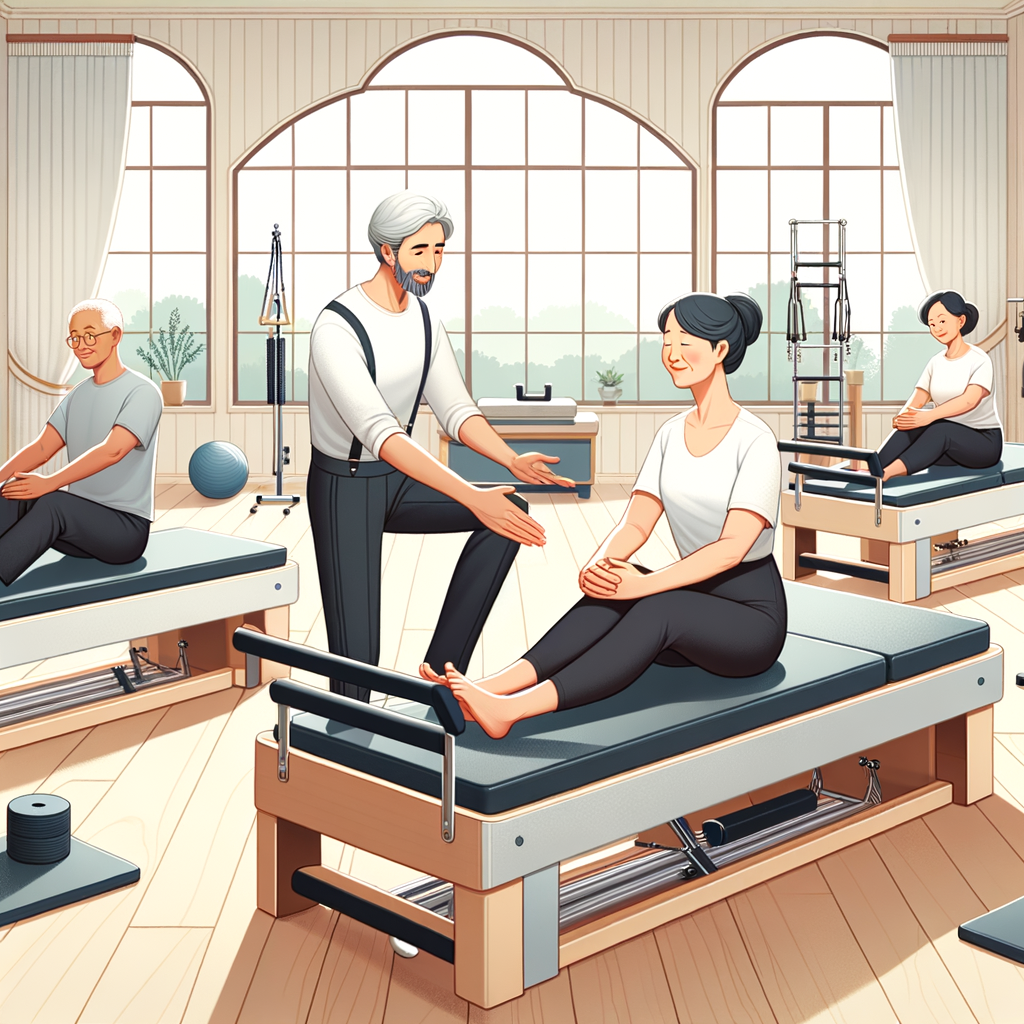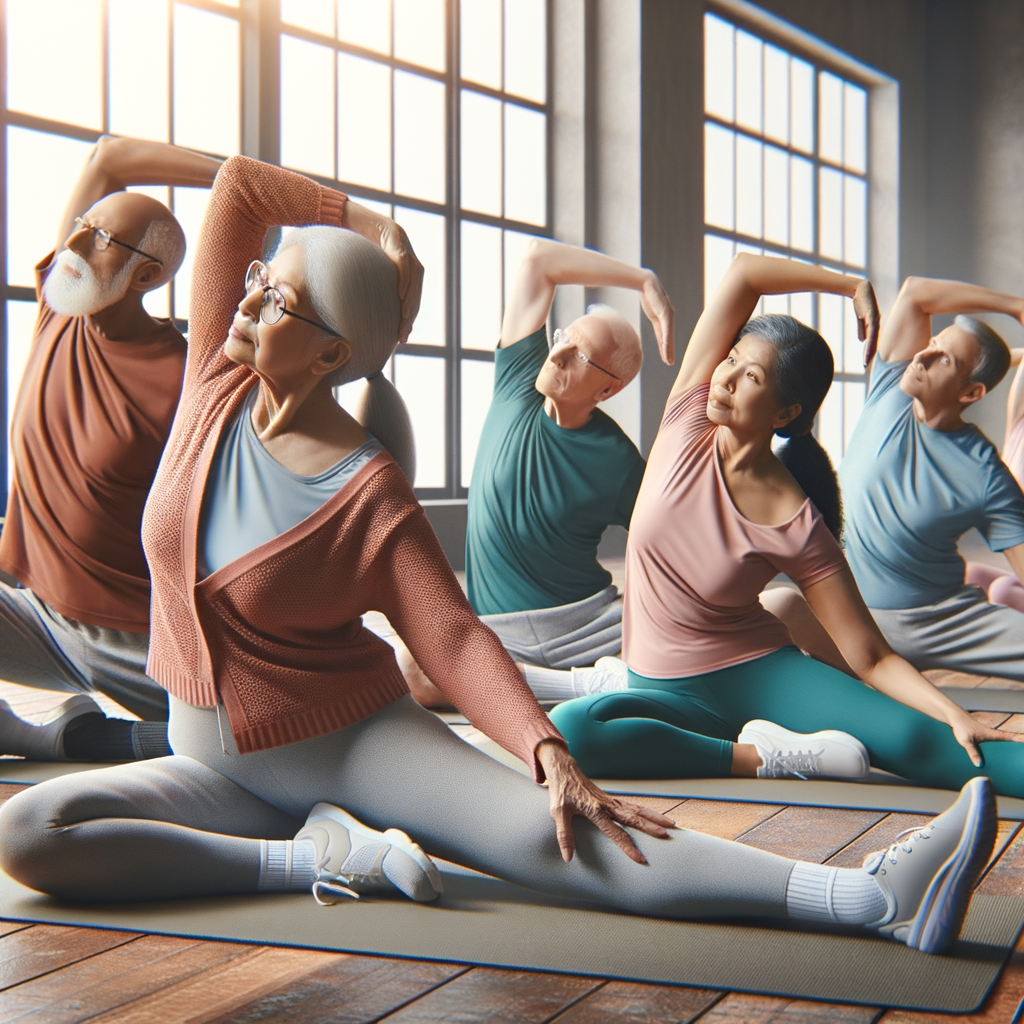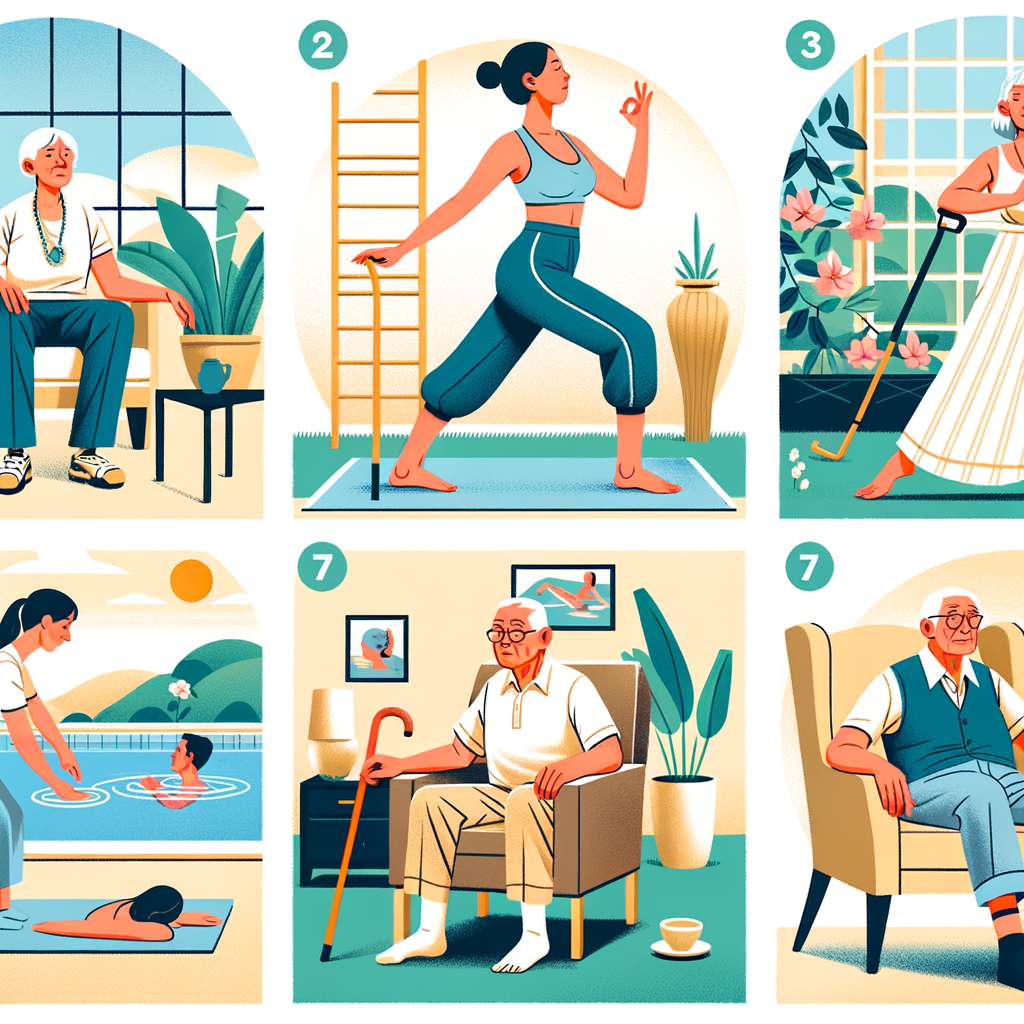Introduction
Staying active is essential at any age, but for seniors, it’s crucial to choose workouts that are gentle on the body yet effective in maintaining health and vitality. This article explores the top 7 gentle workouts for seniors, offering low-impact exercises that deliver high benefits. These workouts are designed to improve flexibility, strength, balance, and overall well-being, ensuring seniors can enjoy an active and fulfilling lifestyle.
please give me a key takeaway section for the article please
Key Takeaways
- Staying Active is Crucial: Regular physical activity is essential for seniors to maintain mobility, flexibility, and overall health. It helps prevent chronic diseases, boosts mental health, and enhances quality of life.
- Gentle Workouts Offer Numerous Benefits: Low-impact exercises such as walking, chair yoga, water aerobics, Tai Chi, strength training, Pilates, and stretching improve cardiovascular health, muscle strength, balance, flexibility, and bone density.
- Mental and Emotional Well-being: Engaging in gentle workouts can reduce stress, improve sleep, boost mood, and provide a sense of accomplishment. They also offer social opportunities, reducing feelings of loneliness and isolation.
- Walking is Accessible and Effective: Walking is an easy, cost-free exercise that improves cardiovascular health and strengthens bones. It’s important to wear supportive shoes and walk in safe, well-lit areas.
- Chair Yoga for Flexibility and Relaxation: Chair yoga improves flexibility, joint health, muscle strength, posture, and relaxation, making it ideal for seniors with limited mobility or balance issues.
- Water Aerobics for a Full-body Workout: The buoyancy of water reduces joint stress while providing an effective cardiovascular and strength workout. It also improves balance and coordination.
- Tai Chi for Balance and Harmony: Tai Chi’s slow, deliberate movements enhance balance, flexibility, relaxation, and mental clarity, making it perfect for seniors.
- Strength Training to Maintain Muscle Mass: Using light weights or resistance bands helps maintain muscle mass, bone density, and overall strength, reducing the risk of falls.
- Pilates for Core Strength: Pilates focuses on core strength, flexibility, posture, and overall body awareness, reducing back pain and injury risk.
- Stretching for Flexibility: Regular stretching maintains flexibility, improves range of motion, and reduces muscle tension and soreness.
- Balanced Workout Routine: Combining different types of exercises ensures comprehensive physical fitness. A mix of cardiovascular, strength, flexibility, and balance activities is recommended.
- Safety and Consistency: Consulting with a doctor, listening to your body, using proper equipment, and staying consistent with exercise routines are key to safe and effective workouts for seniors.
Benefits of Gentle Workouts for Seniors
Importance of Staying Active
As we age, staying active becomes increasingly important. Regular physical activity helps maintain mobility, flexibility, and overall physical health. It also plays a critical role in preventing chronic diseases such as heart disease, diabetes, and arthritis. Moreover, staying active can improve mental health, reducing symptoms of depression and anxiety, and enhancing overall quality of life.
Health Benefits
Gentle workouts offer numerous health benefits for seniors. These exercises help improve cardiovascular health, strengthen muscles, enhance balance, and increase bone density. They also aid in maintaining a healthy weight, which is crucial for preventing obesity-related conditions. Additionally, engaging in regular physical activity boosts the immune system, making it easier to fend off illnesses.
Mental and Emotional Well-being
Exercise is not only beneficial for physical health but also for mental and emotional well-being. Gentle workouts can help reduce stress, improve sleep, and boost mood by releasing endorphins, the body’s natural feel-good hormones. They also provide a sense of accomplishment and can be a great way to socialize, reducing feelings of loneliness and isolation.
Walking: The Simplest Exercise
Why Walking is Beneficial
Walking is one of the simplest and most accessible forms of exercise for seniors. It requires no special equipment and can be done almost anywhere. Walking helps improve cardiovascular health, strengthens bones, and enhances mood. It is also a weight-bearing exercise, which is essential for maintaining bone density and preventing osteoporosis.
Tips for Effective Walking
To get the most out of walking, it’s important to wear comfortable shoes that provide good support. Start with a warm-up to prepare your muscles, and maintain a steady pace that allows you to carry on a conversation. Gradually increase the duration and intensity of your walks as your fitness improves. Incorporating varying terrains, such as gentle hills, can also add a beneficial challenge.
Walking Safety for Seniors
Safety is paramount when it comes to walking for exercise. Always choose well-lit, populated areas for your walks, and consider walking with a friend or in a group. Stay hydrated, and be mindful of weather conditions, avoiding extreme heat or cold. If you have any existing health conditions, consult with your doctor before starting a new walking routine.
Chair Yoga: Flexibility and Relaxation
What is Chair Yoga?
Chair yoga is a gentle form of yoga that is practiced while sitting in a chair or using a chair for support. It is especially suitable for seniors who may have limited mobility or balance issues. Chair yoga offers many of the same benefits as traditional yoga, including improved flexibility, strength, and relaxation.
Benefits of Chair Yoga
Chair yoga is an excellent way to improve flexibility and joint health without putting strain on the body. It helps increase muscle strength, enhances posture, and promotes relaxation. Chair yoga can also improve balance and coordination, reducing the risk of falls. Additionally, it provides a calming effect, reducing stress and anxiety levels.
Basic Chair Yoga Poses
Some simple chair yoga poses that seniors can try include:
- Seated Mountain Pose: Sit up straight with feet flat on the ground, hands resting on thighs. Take deep breaths and focus on maintaining good posture.
- Seated Cat-Cow Stretch: While seated, place hands on knees. Inhale and arch your back, lifting your chest (Cow Pose). Exhale and round your back, tucking your chin towards your chest (Cat Pose). Repeat several times.
- Seated Forward Bend: Sit at the edge of the chair with feet hip-width apart. Inhale and lengthen your spine, then exhale and fold forward from the hips, reaching your hands towards the floor. Hold for a few breaths and then slowly rise back up.
Water Aerobics: Low-Impact Cardiovascular Exercise
Introduction to Water Aerobics
Water aerobics is a form of exercise performed in a swimming pool. It includes a variety of movements such as walking, jogging, and dancing in water, often to music. The buoyancy of water reduces the impact on joints, making it an ideal workout for seniors.
Health Benefits
Water aerobics offers numerous health benefits, including improved cardiovascular fitness, increased muscle strength, and enhanced flexibility. The resistance of water provides a gentle but effective workout for the muscles, while the buoyancy reduces the risk of injury. Water aerobics also helps improve balance and coordination, making it a great exercise for preventing falls.
Getting Started with Water Aerobics
To start with water aerobics, find a local pool that offers senior-friendly classes. These classes are often led by trained instructors who can provide guidance and support. Wear a comfortable swimsuit and consider using water shoes for better traction. Begin with gentle movements and gradually increase the intensity as you become more comfortable.
Tai Chi: Balance and Harmony

Understanding Tai Chi
Tai Chi is an ancient Chinese martial art that involves slow, deliberate movements and deep breathing. It is often described as “meditation in motion” and is known for its ability to improve balance, flexibility, and overall well-being. Tai Chi is particularly beneficial for seniors due to its gentle, low-impact nature.
Benefits for Seniors
Practicing Tai Chi regularly can help seniors enhance their balance and coordination, reducing the risk of falls. It also promotes relaxation, reduces stress, and improves mental clarity. The gentle movements of Tai Chi can help alleviate joint pain and stiffness, making it an excellent exercise for those with arthritis.
Basic Tai Chi Movements
Some simple Tai Chi movements that seniors can practice include:
- Commencement: Stand with feet shoulder-width apart, arms hanging by your sides. Slowly lift your arms to shoulder height, palms facing down, and then lower them back down.
- Parting the Wild Horse’s Mane: Step to one side and gently push one hand forward while the other hand moves back, as if parting a horse’s mane. Repeat on the other side.
- Cloud Hands: Stand with feet shoulder-width apart, and move your hands in a circular motion in front of your body, shifting your weight from one foot to the other.
Strength Training with Light Weights

Importance of Strength Training
Strength training is crucial for maintaining muscle mass, bone density, and overall strength. As we age, muscle mass naturally decreases, but regular strength training can help counteract this process. Strength training also improves balance and reduces the risk of falls, making it an essential component of a senior’s fitness routine.
Choosing the Right Weights
When starting strength training, it’s important to choose weights that are appropriate for your fitness level. Light dumbbells, resistance bands, or even household items like water bottles can be used. The key is to start with a weight that allows you to complete the exercises with proper form but still provides a challenge.
Basic Strength Training Exercises
Some basic strength training exercises that are suitable for seniors include:
- Bicep Curls: Hold a dumbbell in each hand with arms by your sides. Slowly lift the weights towards your shoulders, then lower them back down.
- Leg Lifts: Sit in a chair with feet flat on the floor. Lift one leg straight out in front of you, hold for a few seconds, then lower it back down. Repeat with the other leg.
- Shoulder Presses: Hold a dumbbell in each hand at shoulder height. Slowly lift the weights overhead, then lower them back down.
Pilates: Core Strength and Stability

What is Pilates?
Pilates is a low-impact exercise method that focuses on strengthening the core muscles, improving flexibility, and enhancing overall body awareness. It involves a series of controlled movements and breathing techniques, making it suitable for seniors who want to improve their physical fitness without putting too much strain on their bodies.
Benefits of Pilates
Pilates offers numerous benefits for seniors, including improved core strength, better posture, increased flexibility, and enhanced balance. It also helps alleviate back pain and reduces the risk of injuries. The emphasis on controlled movements and breathing also promotes relaxation and mental focus.
Simple Pilates Exercises for Seniors
Some simple Pilates exercises that seniors can try include:
- Pelvic Tilts: Lie on your back with knees bent and feet flat on the floor. Slowly tilt your pelvis upward, flattening your lower back against the floor, then release.
- Leg Circles: Lie on your back with one leg extended towards the ceiling. Slowly draw circles in the air with your leg, keeping your core engaged. Repeat with the other leg.
- Seated Spine Twist: Sit on the floor with legs extended. Reach your arms out to the sides and slowly twist your torso to one side, then the other, keeping your back straight.
Stretching Exercises for Flexibility

Why Stretching is Important
Stretching is a vital component of any exercise routine, especially for seniors. It helps maintain flexibility, improves range of motion, and reduces the risk of injuries. Regular stretching also helps alleviate muscle tension and soreness, promoting overall physical comfort and mobility.
Effective Stretching Routines
To create an effective stretching routine, focus on all major muscle groups, including the neck, shoulders, arms, back, hips, and legs. Hold each stretch for at least 15-30 seconds, and avoid bouncing or forcing the stretch. Stretching should be done after a warm-up or workout when muscles are warm and pliable.
Stretching Safety Tips
When stretching, it’s important to listen to your body and avoid overstretching, which can lead to injuries. Breathe deeply and relax into each stretch, focusing on gentle movements. If you have any existing health conditions, consult with your doctor before starting a new stretching routine.
Creating a Balanced Workout Routine
Combining Different Exercises
A well-rounded workout routine for seniors should include a combination of cardiovascular exercises, strength training, flexibility exercises, and balance activities. This approach ensures that all aspects of physical fitness are addressed, promoting overall health and well-being.
Weekly Exercise Plan
To create a balanced workout routine, aim to include at least 150 minutes of moderate-intensity aerobic activity each week, along with two or more days of strength training. Incorporate flexibility exercises and balance activities into your daily routine. Adjust the plan based on your fitness level and any specific health considerations.
Adjusting the Routine as Needed
It’s important to listen to your body and adjust your workout routine as needed. If you experience pain or discomfort, modify the exercises or reduce the intensity. Stay flexible with your routine, and don’t hesitate to take rest days when necessary. Consistency is key, but it’s also important to prioritize your health and well-being.
Staying Motivated and Consistent
Setting Realistic Goals
Setting realistic and achievable fitness goals can help keep you motivated and focused. Start with small, manageable goals and gradually increase the difficulty as your fitness improves. Celebrate your progress along the way, no matter how small.
Tracking Progress
Keeping track of your workouts and progress can be a great motivator. Use a journal or an app to log your activities, and regularly review your achievements. Seeing your progress over time can boost your confidence and keep you motivated to continue.
Finding a Workout Buddy
Exercising with a friend or in a group can make workouts more enjoyable and provide added motivation. A workout buddy can help keep you accountable, provide encouragement, and make exercising a social activity. Look for local senior fitness classes or walking groups to connect with others.
Safety Tips for Senior Workouts
Consulting with a Doctor
Before starting any new exercise routine, it’s important to consult with your doctor, especially if you have any existing health conditions or concerns. Your doctor can provide guidance on safe exercises and any precautions you should take.
Listening to Your Body
Always listen to your body and pay attention to how you feel during and after exercise. If you experience pain, dizziness, or shortness of breath, stop exercising and seek medical advice. It’s important to exercise at a pace that feels comfortable and manageable for you.
Using Proper Equipment
Using the proper equipment can help ensure your workouts are safe and effective. Wear appropriate clothing and footwear, and use any necessary support tools, such as resistance bands or chairs. If you’re exercising at a gym or pool, make sure the equipment is in good condition and suitable for your needs.
FAQs
How often should seniors exercise? Seniors should aim to engage in moderate-intensity aerobic activity for at least 150 minutes per week, along with strength training exercises two or more days a week. Flexibility and balance exercises can be incorporated into daily routines.
What are the best exercises for seniors with arthritis? Gentle exercises such as walking, water aerobics, chair yoga, and Tai Chi are excellent for seniors with arthritis. These activities are low-impact and help improve joint flexibility and reduce pain.
Can seniors start exercising if they have never exercised before? Yes, it’s never too late to start exercising. Begin with gentle, low-impact activities and gradually increase the intensity as your fitness improves. Always consult with your doctor before starting a new exercise routine.
What precautions should seniors take when exercising? Seniors should consult with their doctor before starting any new exercise routine, listen to their bodies, and avoid overexertion. Using proper equipment and choosing safe environments for exercise are also important.
Are there any exercises seniors should avoid? Seniors should avoid high-impact activities that put excessive strain on the joints, such as running or jumping. It’s also important to avoid exercises that involve heavy lifting or abrupt, jerky movements.
How can seniors stay motivated to exercise regularly? Setting realistic goals, tracking progress, finding a workout buddy, and choosing enjoyable activities can help seniors stay motivated. Incorporating exercise into daily routines and varying workouts can also keep things interesting.
Conclusion
Staying active with gentle workouts is essential for seniors to maintain their health, mobility, and overall well-being. The top 7 gentle workouts discussed in this article—walking, chair yoga, water aerobics, Tai Chi, strength training with light weights, Pilates, and stretching—offer low-impact options that provide significant benefits. By incorporating these exercises into a balanced routine, seniors can enjoy a healthier, more active lifestyle. Remember to consult with a healthcare professional before starting any new exercise program and listen to your body to ensure a safe and enjoyable workout experience.
